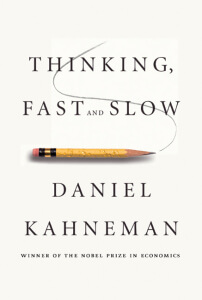 Market researchers know that consumers behave in unpredictable, irrational ways. Daniel Kahneman was not the person who brought that to our attention. Still, we often struggle with how to use this understanding to inform research designs. Research designs which are often intended to do the best possible job of identifying and measuring consumer attitudes and behaviors. What Kahneman’s book did do is to give us A) a language for discussing consumer decision making, and B) awareness of specific issues that can be leveraged to improve research designs.
Market researchers know that consumers behave in unpredictable, irrational ways. Daniel Kahneman was not the person who brought that to our attention. Still, we often struggle with how to use this understanding to inform research designs. Research designs which are often intended to do the best possible job of identifying and measuring consumer attitudes and behaviors. What Kahneman’s book did do is to give us A) a language for discussing consumer decision making, and B) awareness of specific issues that can be leveraged to improve research designs.
For me, as a market researcher, I found the book both inspirational and practical. Its many examples lend credibility to its conclusions, and I have found myself referring to the cited experiments on many occasions. My copy’s pages are dog-eared and covered in notes. If you haven’t had a chance to read it yet, here are some reviews, as summarized by Research Rockstar intern Audra Kohler.
–Kathryn Korostoff
Review #1, by Max H. Bazerman of Harvard University.
Thinking, Fast and Slow, published in 2011, adopts Stanovich and West’s System 1 and System 2 distinction. As summarized by Bazerman, “System 1 thinking, or the intuitive reactions and quick judgments that we rely on for most decisions, is also the process that leads to far greater biases in judgment.” He continues, “System 2, our more deliberative thought processes, can be used to dampen the negative effects of our intuitive judgments.” Bazerman concludes that Kahneman’s book is extremely thorough in the assessment of when we need to apply System 2 processes, but also describes intuition in a more positive way than what other behavioral researchers may expect.
Review #2, by Sid Groeneman of Groeneman Research & Consulting.
Groeneman concludes that this book is extremely applicable to market research. Groeneman, head of Groeneman Research and Consulting, recommends the book for, “…anyone wanting to understand how business decisions are made.” How can market researchers utilize Kahneman’s studies in an effective way? We must know when System 1 and System 2 behavioral processes are likely being used, and how to adjust our targeting to fit those systems.
TED Talk: Sheena Iyengar
In a related TED Talk by Sheena Iyengar, we can see an example of how Kahneman’s observations apply to consumer behavior. In the TED talk, Iyengar discusses the problem of making choices, and she asserts that over 70 choices are made every day by the typical American. Iyengar discusses a research experiment she conducted at a grocery store. In this experiment, researchers showcased six types of jam and then at a different time, 24 types of jam. More people stopped when there were more types of jam offered, but only 3 percent completed the purchase. Out of the people that stopped when there were six options, 30 percent of people purchased the jam. The choice overload problem affects us in very consequential decisions; we choose not to choose.
About Daniel Kahneman
In 2002, Daniel Kahneman won the Nobel prize in economic science. Amos Tversky, the second half of the noted duo, passed away in 1996, or would have shared the Nobel with Kahneman. Kahneman is extremely interested in human irrationality; in fact it was with “prospect theory,” an alternative account of decision making, for which he won the Nobel. Currently, he is a professor at Princeton University.
Further recommended reading: A third excellent review of the book was published in The New York Times; Two Brains Running, by Jim Holt.
[Want access to more market research articles and training materials? Sign up for the Research Rockstar newsletter: SIGNUP]








